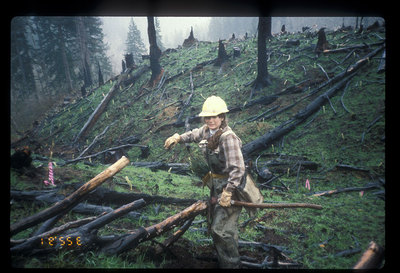For the first fifty years of Oregon Agricultural College’s (OAC) existence, the institution served as both a place of higher learning and a secondary school, with groups of men and women alike pursuing coursework to complete the equivalent of a high school diploma. As the collegiate mission at OAC began to develop greater cohesion in the late 1800s, the majority of women matriculated into the Domestic Arts and Sciences.
In 1866, the “Collegiate Department” had eight students – all men – while the “Preparatory Department” had 50 men and 58 women. Alice E. Biddle, preparatory student in 1866, completed her Bachelor of Science degree as part of Corvallis College’s first graduating class in 1870. A second woman, Annie Finley, was a college-level student with Biddle in 1867, but dropped out before the 1868/1869 academic year.
In 1870, Ida Burnett matriculated into Corvallis College’s primary department. Eleven years later, she graduated with a Bachelor of Science degree, and in 1883 began working as an assistant in the Preparatory Department. She served as principal of the Preparatory Department (1894-1895), instructor in English (1896-1932), and Dean of Women (1906-1907). She was matron of Alpha House, the first residence hall on campus and one that later housed women. It’s fitting that Callahan Hall, originally a residence for female students, was named for her.
Though women were never formally restricted from studying in any specific discipline, prevailing social pressures, combined with the realities of life in rural Oregon – from where the bulk of Oregon State’s students hailed – resulted in a campus where the vast majority of women studied Home Economics. Within this ecosystem, however, dramatic curricular shifts certainly occurred: whereas Margaret Snell (1889-1908) had stressed the practicalities of sewing, cooking and hygiene to her students, Ava Milam Clark, who led Home Economics from 1911 to 1950, emphasized the liberal arts, sciences, and social sciences as a means for broadening horizons within the purview of a Home Economics education.
In addition to Home Economics, women at Oregon State tended to favor study in Commerce - particularly Secretarial Science - and Education until at least the 1950s. While patterns began to shift during the 1960s, it was not until the late 1970s that women students at OSU began to make significant inroads in disciplines traditionally dominated by men. This did not happen in a vacuum. Though Title IX is most typically associated with a revolution in athletics, its anti-discrimination language made a significant impact in the classroom as well, helping to contribute to the more dispersed gender dynamic seen across colleges and departments today.
Although they are now separate, the Hattie Redmond Women and Gender Center, and the Women, Gender, and Sexuality Studies program share a common history. The Center for Women Studies was formed in 1972 under the leadership of Jeanne Dost, an economist, educator, author, and political activist who was on the Oregon State University faculty from 1965 to 1991. Dost, along with Jo Anne Trow (see Administration section), Margaret Lumpkin, and Gwyneth Britton led efforts to increase university services for women and expand opportunities to explore gender issues.
Critical among these opportunities was the Women’s Studies curriculum, initially offered as a loose collection of classes housed in the newly created Women’s Center as well as OSU’s Experimental College. An interdisciplinary certificate option in “Women Studies” was formalized in Fall 1978 with a focus on “contemporary women's issues,” including changing gender roles, feminism, the labor market, and independent experiential learning projects. The curriculum was made available to graduate students through the Master of Arts in Interdisciplinary Studies program beginning in Fall 1983.
Over time, the program expanded and evolved to reflect changing social norms, expectations, and issues. In 2012, the department joined Anthropology, Ethnic Studies, and World Languages and Cultures to create the School of Language, Culture, and Society. At that same time, the program was renamed “Women, Gender, and Sexuality Studies” to reflect a "deepening commitment to queer studies and work on sexuality more broadly, as well as scholarship regarding gender constructions and processes, and critical men and masculinity studies." Today the program offers a Ph.D., an M.A., and a B.A., as well as minors in WGSS and Queer Studies at the undergraduate and graduate levels.

